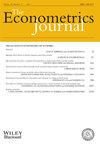Debiased machine learning of conditional average treatment effects and other causal functions
IF 2.9
4区 经济学
Q1 ECONOMICS
引用次数: 114
Abstract
This paper provides estimation and inference methods for the best linear predictor (approximation) of a structural function, such as conditional average structural and treatment effects, and structural derivatives, based on modern machine learning (ML) tools. We represent this structural function as a conditional expectation of an unbiased signal that depends on a nuisance parameter, which we estimate by modern machine learning techniques. We first adjust the signal to make it insensitive (Neyman-orthogonal) with respect to the first-stage regularization bias. We then project the signal onto a set of basis functions, growing with sample size, which gives us the best linear predictor of the structural function. We derive a complete set of results for estimation and simultaneous inference on all parameters of the best linear predictor, conducting inference by Gaussian bootstrap. When the structural function is smooth and the basis is sufficiently rich, our estimation and inference result automatically targets this function. When basis functions are group indicators, the best linear predictor reduces to group average treatment/structural effect, and our inference automatically targets these parameters. We demonstrate our method by estimating uniform confidence bands for the average price elasticity of gasoline demand conditional on income.条件平均处理效果和其他因果函数的去偏机器学习
本文基于现代机器学习(ML)工具,提供了结构函数的最佳线性预测(近似)的估计和推理方法,如条件平均结构和治疗效果,以及结构导数。我们将这种结构函数表示为对无偏信号的条件期望,该无偏信号取决于我们通过现代机器学习技术估计的干扰参数。我们首先调整信号,使其相对于第一阶段正则化偏差不敏感(Neyman正交)。然后,我们将信号投影到一组基函数上,随着样本量的增加而增长,这为我们提供了结构函数的最佳线性预测值。我们导出了一组完整的结果,用于对最佳线性预测器的所有参数进行估计和同时推理,通过高斯自举进行推理。当结构函数是光滑的并且基础足够丰富时,我们的估计和推理结果自动地针对该函数。当基函数是组指标时,最佳线性预测因子减少为组平均治疗/结构效应,并且我们的推断自动针对这些参数。我们通过估计以收入为条件的汽油需求平均价格弹性的统一置信区间来证明我们的方法。
本文章由计算机程序翻译,如有差异,请以英文原文为准。
求助全文
约1分钟内获得全文
求助全文
来源期刊

Econometrics Journal
管理科学-数学跨学科应用
CiteScore
4.20
自引率
5.30%
发文量
25
审稿时长
>12 weeks
期刊介绍:
The Econometrics Journal was established in 1998 by the Royal Economic Society with the aim of creating a top international field journal for the publication of econometric research with a standard of intellectual rigour and academic standing similar to those of the pre-existing top field journals in econometrics. The Econometrics Journal is committed to publishing first-class papers in macro-, micro- and financial econometrics. It is a general journal for econometric research open to all areas of econometrics, whether applied, computational, methodological or theoretical contributions.
 求助内容:
求助内容: 应助结果提醒方式:
应助结果提醒方式:


